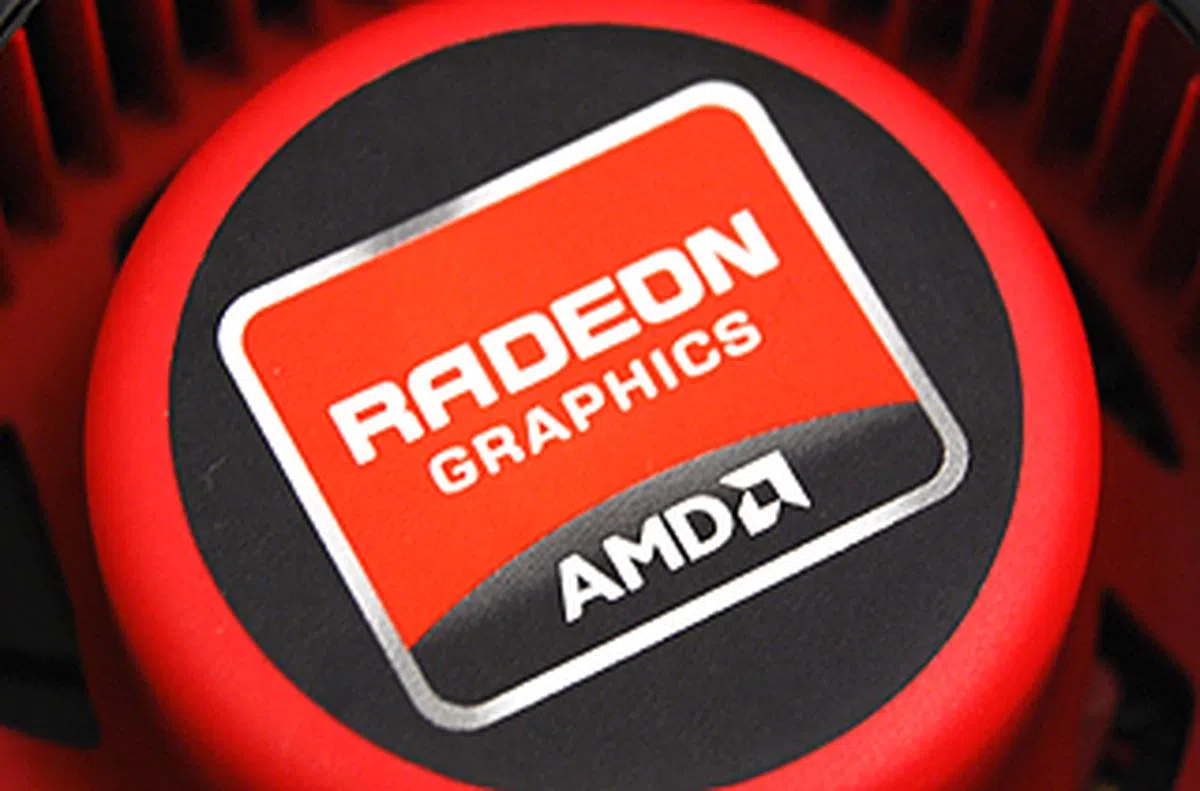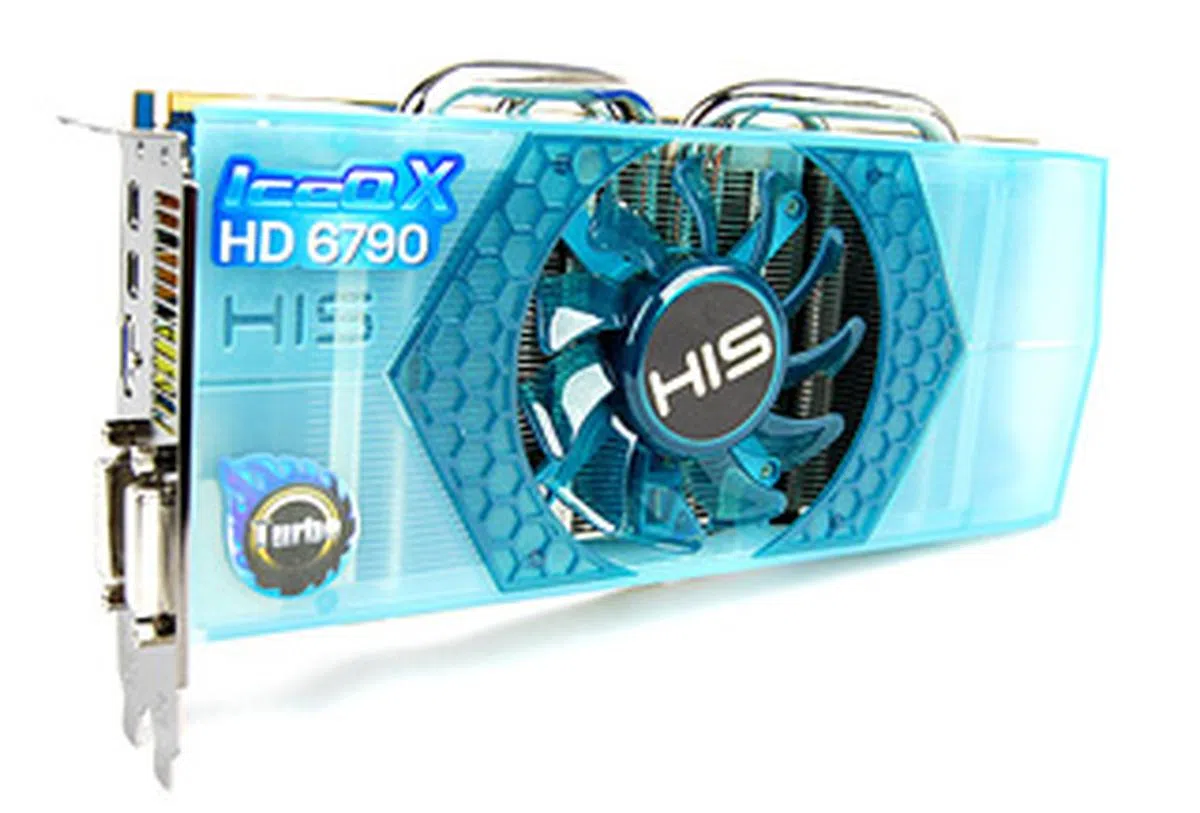AMD Radeon HD 6790 - Confusing and Unnecessary
We check out AMD's new Radeon HD 6790 with HIS' 6790 IceQ X Turbo. The card boasts the company's signature IceQ X cooler and is factory overclocked for better performance. But is it worth the money against a Radeon HD 6850? Read on.
By Kenny Yeo -
Confusing Nomenclature
AMD’s Radeon HD 6000 series (Northern Islands) has come under threat recently thanks to NVIDIA’s recent releases. Thanks to the better optimized GF110 chip, NVIDIA has quite successfully rejuvenated their Fermi series of cards. The hot and extremely power hungry cards such as the GeForce and are now days of the past. And today, the awesome leads the way with recent releases such as the and GTX 550 Ti have combining great performance, efficiency and affordability.
The aforementioned GeForce GTX 550 Ti was NVIDIA’s latest part, and was meant to replace the older . Changes at the transistor level and improved clock speeds have greatly increased the performance of the GeForce GTX 550 Ti over the older GTS 450, but the new part still trails the GeForce GTX 460 and GeForce GTX 560 Ti greatly.
With NVIDIA still scrambling for something to plug the gap, AMD has seized the chance to release their own new card. Aimed at the mainstream segment and set to go head to head against the GeForce GTX 550 Ti, AMD has introduced the Radeon HD 6790. Confusingly, despite being introduced as the first card in the Radeon HD 6700 series, the HD 6790 is actually powered by a variant of the Barts GPU used in both the .

The latest card from AMD is the Radeon HD 6790 and it effectively uses a scaled-down version of the Barts chip that powers the earlier Radeon HD 6870 and HD 6850.
Specifically, the Radeon HD 6790 uses a variant of the Barts GPU and is codenamed Barts LE. It has 800 stream processing units, which is 160 lesser than the Radeon HD 6850 and 320 down compared to the Radeon HD 6870. And compared to its closest relative, the Radeon HD 6850, the Radeon HD 6790 will have 8 less texture mapping units at 40, but the same number of raster operating units at 32. Also, like the cards in the Radeon HD 6800 series, the Radeon HD 6790 will have 1GB of GDDR5 framebuffer running on a 256-bits wide memory bus interface. Clock speeds, however, have been boosted to 840MHz at the core and 4200MHz DDR at the memory, which are higher than the Radeon HD 6850’s equivalent 775MHz and 4000MHz DDR.
Finally and curiously, the Radeon HD 6790 will have a higher rated TDP of 150W, as compared to the HD 6850’s 127W. This is unusual considering the Radeon HD 6790 is positioned as a less powerful product, but we will reveal in our power consumption tests later in the article to see if the Radeon HD 6790 will indeed consume more power under real world testing conditions.
In many ways then, judging from past releases, the Radeon HD 6790 should really have been the Radeon HD 6830. AMD’s decision to name it the Radeon HD 6790 is beyond us, but it wouldn’t be an understatement to say that the current nomenclature of the Radeon series is pretty darn confusing, even for us.
Anyhow, here’s how the card stacks up against competitive SKUs.
Model | AMDRadeon HD 6790 | AMDRadeon HD 6850 | ATIRadeon HD5770 | NVIDIAGeForce
GTX 550 Ti | NVIDIAGeForce GTS 450 | NVIDIAGeForce GTX 460 |
Core Code | Barts LE | Barts PRO | Juniper XT | GF116 | GF106 | GF104 |
Transistor Count | 1700 million | 1700 million | 1040 million | 1170 million | 1170 million | 1950 million |
Manufacturing Process | 40nm | 40nm | 40nm | 40nm | 40nm | 40nm |
Core Clock | 840MHz | 775MHz | 850MHz | 900MHz | 783MHz | 675MHz |
Stream Processors | 800 Stream Processing Units | 960 Stream Processing Units | 800 Stream Processing Units | 192 Stream Processors | 192 Stream Processors | 336 Stream Processors |
Stream Processor Clock | 840MHz | 775MHz | 850MHz | 1800MHz | 1566MHz | 1350MHz |
Texture Mapping Units (TMU) or Texture Filtering (TF) units | 40 | 48 | 40 | 32 | 32 | 56 |
Raster Operator units (ROP) | 32 | 32 | 16 | 24 | 16 | 24 |
Memory Clock | 4200MHz DDR | 4000MHz DDR | 4800MHz DDR | 4100MHz GDDR5 | 3608MHz GDDR5 | 3600MHz GDDR5 |
DDR Memory Bus | 256-bit | 256-bit | 128-bit | 192-bit | 128-bit | 192 / 256-bit |
Memory Bandwidth | 134.4GB/s | 128GB/s | 76.8GB/s | 98.5GB/s | 57.7GB/s | 86.4 / 115.2GB/s |
PCI Express Interface | PCIe ver 2.0 x16 | PCIe ver 2.0 x16 | PCIe ver 2.0 x16 | PCIe ver 2.0 x16 | PCIe ver 2.0 x16 | PCIe ver 2.0 x16 |
Molex Power Connectors | 2 x 6-pin | 1 x 6-pin | 1 x 6-pin | 1 x 6-pin | 1 x 6-pin | 2 x 6-pin |
Multi GPU Technology | CrossFireX | CrossFireX | CrossFireX | SLI | SLI | SLI |
DVI Output Support | 1 x Single-Link, 1 x Dual-Link | 1 x Single-Link, 1 x Dual-Link | 2 x Dual-Link | 2 x Dual-Link | 2 x Dual-Link | 2 x Dual-Link |
HDMI | 1 | 1 | 1 | 1 (mini-HDMI) | 1 (mini-HDMI) | 1 (mini-HDMI) |
DisplayPort | Yes (DisplayPort 1.2) | Yes (DisplayPort 1.2) | 1 | None | None | None |
HDCP Output Support | Yes | Yes | Yes | Yes | Yes | Yes |
Street Price | Launch price: US$150 | ~US$174 | ~US$129 | ~US$159 | ~US$129 | ~US$199 |
The HIS 6790 IceQ X Turbo 1GB GDDR5
On first impressions, the HIS 6790 IceQ X Turbo looks like any other of HIS’ other Radeon HD 6800 series cards. The familiar and signature ice-blue IceQ X cooler aside, the HIS 6790 IceQ X Turbo is the exact same length as the Radeon HD 6870 and HD 6850. It also has the same single CrossFireX connector and for video output connectivity, it sports the same twin DVI ports, single HDMI port and dual version 1.2 DisplayPorts.
The HIS 6790 IceQ X Turbo is also factory overclocked with the core running at a respectable 900MHz while the memory at 4400MHz DDR - a bump of 60MHz and 200MHz DDR respectively.
Here's a look at the card.

The HIS 6790 IceQ X Turbo bares some resemblance to HIS' reference Radeon HD 6850 and especially identical to its other IceQ X series.

The card has the usual twin DVI ports, twin DisplayPort 1.2 ports, and single full-sized HDMI port.

Four thick copper heat pipes are used to draw heat away from the GPU core, which is then dissipated amongst the numerous cooling fins. The large 92mm fan in turn cools the fins.

AMD clarified that the Radeon HD 6790 may come with one or two PCIe power connectors, but since it is said that first batches of Radeon HD 6790 cards to hit the market are said to be based on the Radeon HD 6870, many if not all will come with two power connectors.
Test Setup
The new card will be tested using our Intel X58 system which has the following specifications:
- Intel Core i7-975 (3.33GHz)
- Gigabyte GA-EX58-UD4P motherboard
- 3 x 1GB DDR3-1333 G.Skill memory in triple channel mode
- Seagate 7200.10 200GB SATA hard drive
- Windows 7 Ultimate
Since we don’t have a reference Radeon HD 6790 on hand, we will be downclocking the HIS 6790 IceQ X Turbo to simulate the scores of a reference Radeon HD 6790. Key comparisons here will obviously be between the Radeon HD 6790 and the GeForce GTX 550 Ti, but we are also interested to see where the Radeon HD 6790 stands in AMD’s current lineup of cards and so we have also presented results of the Radeon HD 6850 along with the older Radeon HD 5770 and HD 5750. Lastly, we also want to find out how HIS’ custom Radeon HD 6790 performs.
- AMD Radeon HD 6790 1GB GDDR5 (Catalyst 11.4)
- AMD Radeon HD 6850 1GB GDDR5 (Catalyst 10.12)
- ATI Radeon HD 5770 1GB GDDR5 (Catalyst 11.2)
- ATI Radeon HD 5750 1GB GDDR5 (Catalyst 11.2)
- NVIDIA GeForce GTX 550 Ti (ForceWare 266.71)
- NVIDIA GeForce GTS 450 1GB GDDR5 (ForceWare 266.58)
- NVIDIA GeForce GTX 460 1GB GDDR5 (ForceWare 266.58)
The list of benchmarks used:
- Futuremark 3DMark Vantage
- Futuremark 3DMark 11
- Crysis Warhead
- Far Cry 2
- Warhammer: Dawn of War 2
- Battlefield Bad Company 2
- “Heaven" from Unigine v2.1
- S.T.A.L.K.E.R.: Call of Pripyat
3DMark11 & 3DMark Vantage Results
Our simulated reference Radeon HD 6790 scored about 10% lower compared to the Radeon HD 6850, but managed to comfortably outscore the GeForce GTX 550 Ti by more than 15%. The HIS 6790 IceQ X Turbo, on the other hand, scored about 5% more than a reference-clocked Radeon HD 6790.

On 3DMark Vantage, the new Radeon HD 6790 continued to easily outperform the GeForce GTX 550 Ti, it’s main rival from NVIDIA. On average, the reference Radeon HD 6790 was about 10% quicker than a reference GeForce GTX 550 Ti.
The factory overclocked HIS 6780 IceQ X Turbo, thanks to its higher clock speeds, recorded scores that were about 5% greater than our simulated reference Radeon HD 6790.

Crysis Warhead & Far Cry 2 Results
Moving on to real-world gaming applications, the Radeon HD 6790 once again showed that it is markedly faster than a GeForce GTX 550 Ti. On a whole, it was more than 20% faster, which is certainly impressive. The Radeon HD 6790 was also significantly quicker than the older Radeon HD 5770, by more than 20% overall.
However, we noticed that it couldn't quite match up to the Radeon HD 6850. The difference wasn’t much when anti-aliasing was disabled, but when enabled, the Radeon HD 6850 was about 15% quicker.
The HIS 6790 IceQ X Turbo was again about 5% quicker than a reference Radeon HD 6790.


Far Cry 2 has traditionally been an NVIDIA stronghold, so to speak, as the cards from the green camp usually perform well on his benchmark. Here, the GeForce GTX 550 Ti managed a comeback, outscoring our reference-clocked Radeon HD 6790 by around 20% on average.
And while the Radeon HD 6790 was faster than the old Radeon HD 5770, it continued to trail the Radeon HD 6850, by more than 30%. The HIS 6790 IceQ X Turbo put up a consistent performance, and although it wasn't quite as fast as a Radeon HD 6850, it maintained its 5% advantage over our simulated reference-clocked card.


Dawn of War 2 & Battlefield Bad Company 2 Results
It was tightly contested on Dawn of War 2. Although the Radeon HD 6790 was faster than a GeForce GTX 550 Ti, the difference wasn’t as great as previous benchmarks. Also, on the most intensive resolutions of 1650 x 1050 and 1920 x 1200, the Radeon HD 6850 was as much as 25% faster than a Radeon HD 6790.

On Battlefield Bad Company 2, the Radeon HD 6790 lost its advantage against the GeForce GTX 550 Ti. On the 1680 x 1050 resolution, the GeForce GTX 550 Ti managed a slight lead, but lost most of its momentum as soon as we moved on to 1920 x 1200. The Radeon HD 6790 continued to trail against the more powerful Radeon HD 6850, by more than 25% overall. What's also worth noting is that despite the rather intensive settings, the Radeon HD 6790 still managed respectable and playable frame rates.
The factory overclocked HIS 6790 IceX Turbo was more than 5% quicker than our simulated reference card, which is certainly decent given its level of boosted clock speeds.

Unigine 2.1 "Heaven" Benchmarks
NVIDIA cards have usually performed better when it came to tessellation-heavy applications, but even on Unigine, the Radeon HD 6790 maintained a slight superiority over the GeForce GTX 550 Ti. It might be faster, but the difference in raw frame rates was only about 2 - 3fps. And surprisingly, the Radeon HD 6790 was also competitive against the Radeon HD 6850, which the newcomer probably compensated via its higher clock speeds despite the reduced shader units. Yet another reason could be due to the newer preview Catalyst drivers the Radeon HD 6790 is running on, but that’s something we can only confirm in future.
The HIS 6790 IceQ X Turbo, with its higher clock speeds, maintained its 5% greater frame rates compared to a reference-clocked Radeon HD 6790. But at this low levels, we doubt anyone will notice the difference in frame rates.
DirectX 11 Results


DirectX 10 Results

S.T.A.L.K.E.R.: Call of Pripyat Results
On S.T.A.L.K.E.R.: Call of Pripyat, it was a stalemate between our simulated Radeon HD 6790 and the GeForce GTX 550 Ti, seeing that both cards managed frame rates that were pretty close, although it could be argued that the Radeon HD 6790 was marginally faster. The reference-clocked Radeon HD 6790 also trailed the Radeon HD 6850, especially when we disabled tessellation and ran using the older DirectX 10 API.
The HIS 6790 IceQ X Turbo, with its higher clock speeds, maintained its steady performance posting frame rates that were about 5% faster than a reference card. It could even match the Radeon HD 6850 when we enabled tessellation.
DirectX 11 Results
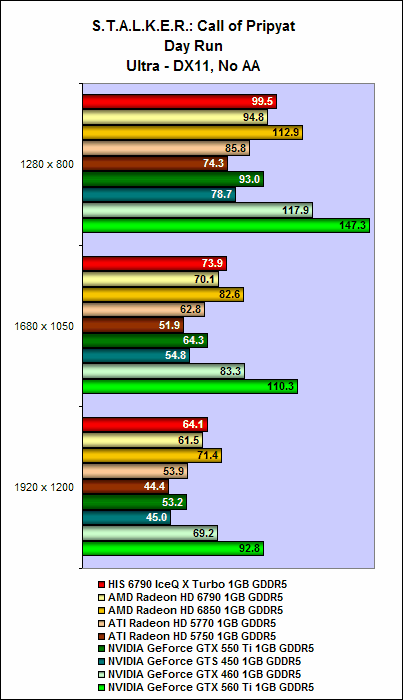 | 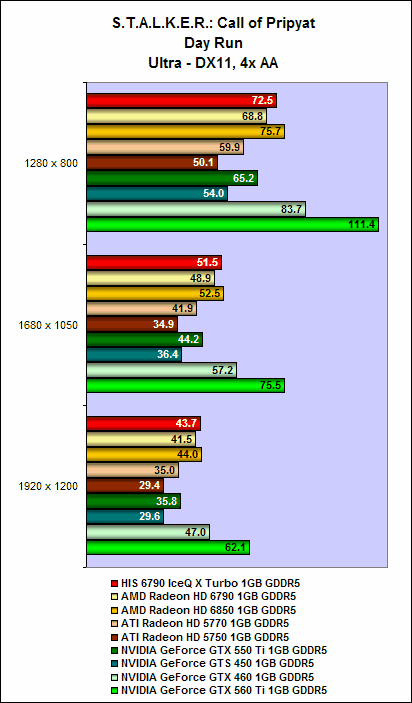 |
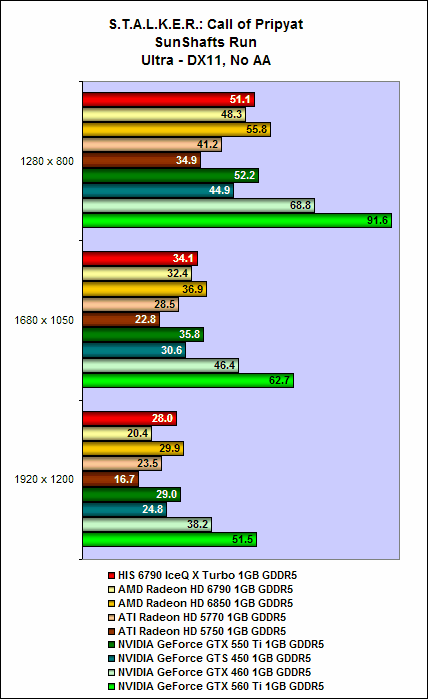 | 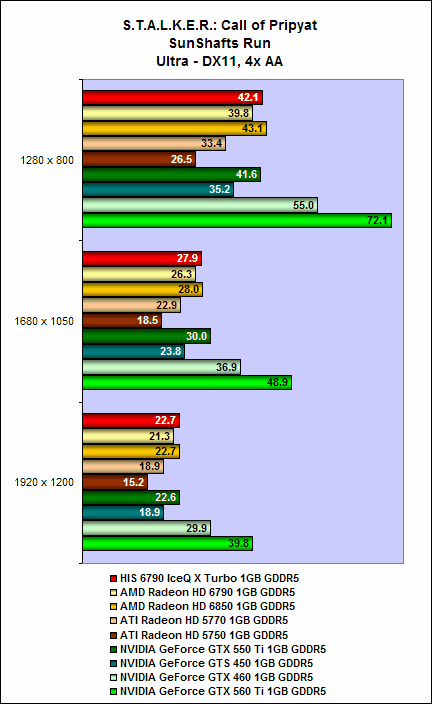 |
DirectX 10 Results
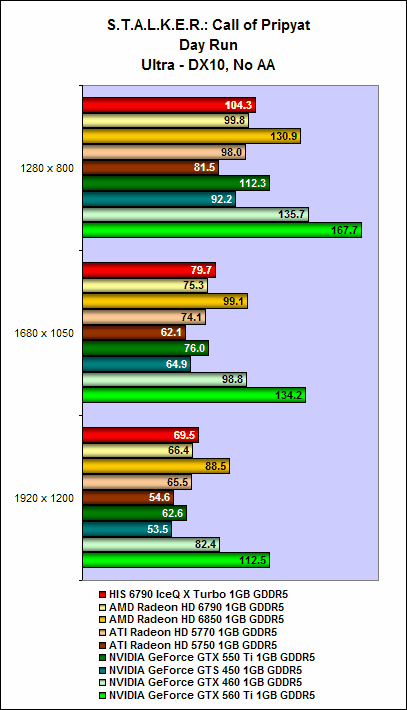 | 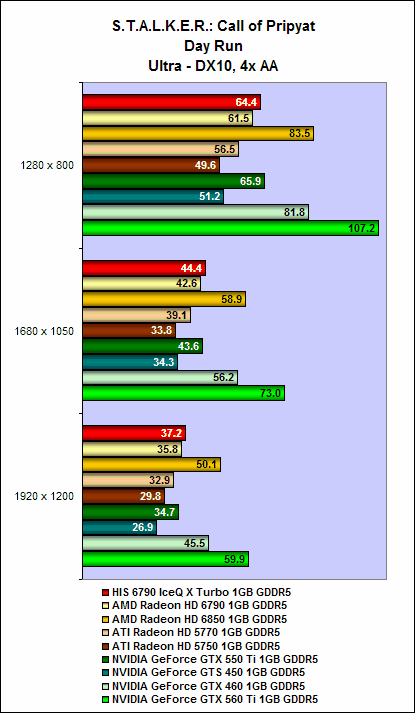 |
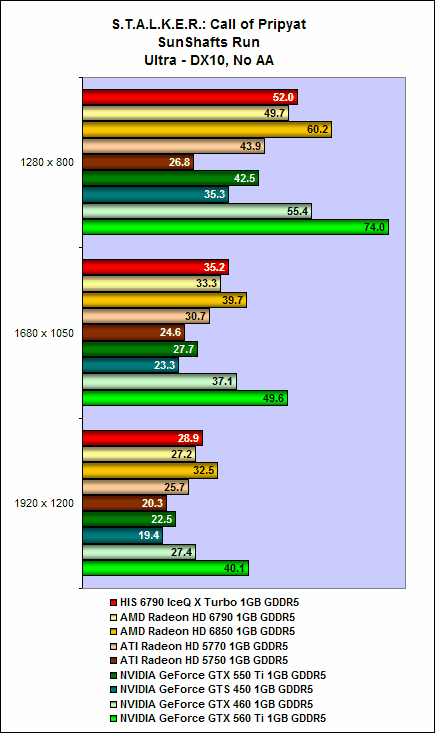 | 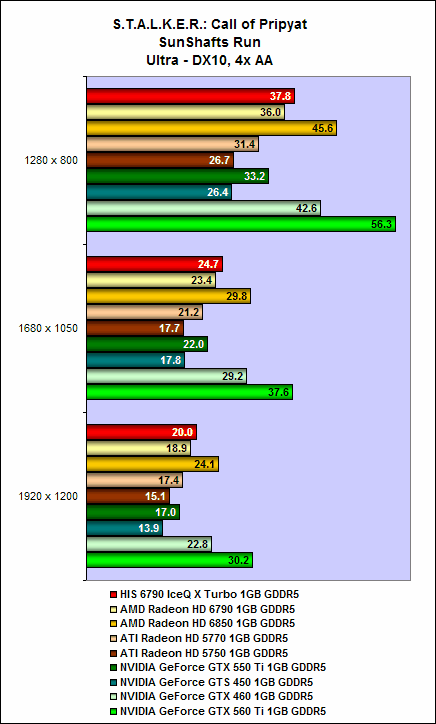 |
Temperature
The HIS 6790 IceQ X Turbo recorded a cool 61 degrees Celsius at load, markedly cooler than both reference versions of the Radeon HD 6850 and HD 5770. Although we did not have a reference GeForce GTX 550 Ti card to use as comparison, it is worth noting that the MSI N550GTX-Ti Cyclone II OC was one of the coolest GTX 550 cards we have tested and it recorded a super cool 52 degrees Celsius.
We did not include results of our simulated Radeon HD 6790 because it won't be a fair estimation - after all, it is still using HIS' custom IceQ X cooler.

Power Consumption
According to AMD, the Radeon HD 6790 has a rated TDP of 150W, which exceeds that of the Radeon HD 6850 (127W) and is almost on a par with the Radeon HD 6870 (151W). In this instance, though the HIS 6790 IceQ X Turbo recorded power draw figures that were significantly lower than the Radeon HD 6870, but matched that of the Radeon HD 6850. Although the effects of this in real world usage is negligible, it’s disappointing finding nonetheless. If it’s any consolation, the GeForce GTX 550 Ti in the form of the MSI N550GTX-Ti Cyclone II OC recorded marginally higher power draw figures.

Overclocking
The HIS 6790 IceQ X Turbo was an able overclocker, as we managed a staggering 1000MHz at the core and 5000MHz DDR at the memory using the MSI Afterburner overclocking software. This allowed it to record 6542 3DMarks, an improvement of 11% over its stock form and 20% over a reference-clocked Radeon HD 6790. In its overclocked state, it also managed to outscore the Radeon HD 6850.

The Enemy is Thyself
In terms of performance, the new Radeon HD 6790 is the perfect foil to NVIDIA’s GeForce GTX 550 Ti. In most instances, the Radeon comfortably beats the GeForce GTX 550 Ti while operating at moderate temperatures and consuming slightly less power. But is it the perfect mainstream card? Unfortunately not, let us explain why.
The main problem with it is its price. Its launch price of US$150 means AMD has targeted it squarely at the GeForce GTX 550 Ti, which is now going for around US$149 in the market. And if you were to compare the two, then the Radeon HD 6790 certainly provides more bang for buck as it is markedly faster than the GeForce GTX 550 Ti.
However, the problem with the Radeon HD 6790 is that for a little more, one could snag the more powerful and power efficient Radeon HD 6850. Considering reference Radeon HD 6850 cards can be had for as little as US$165, this means that a more powerful card can be had for as little as US$15 more. The Radeon HD 6850 is therefore the better buy if we were to compare the two. With its pricing, the Radeon HD 6790 doesn't really fill any gaps, so to make the Radeon HD 6790 attractive, AMD should have priced it slightly lower to differentiate it from the Radeon HD 6850.
And so, while the Radeon HD 6790 convincingly trumps its rival from NVIDIA - the GeForce GTX 550 Ti - it is at odds with its own and more powerful sibling, the Radeon HD 6850. As such, unless US$150 is already a stretch for you, there’s simply no compelling reason to get the Radeon HD 6790 over the older but faster HD 6850.

Ironically, the biggest competition that the Radeon HD 6790 faces comes not from NVIDIA, but from its older Radeon HD 6850 counterpart.
Lastly, the custom edition HIS 6790 IceQ X Turbo is a solid take on the SKU by HIS. It runs remarkable cool, has great overclocking potential, and provides decent performance out of the box. It some instances, it even matches the Radeon HD 6850, and that’s a commendable effort. At US$159, it costs only slightly more than the launch price of the Radeon HD 6790, but then again, a few dollars more would snag you a real Radeon HD 6850. If you really must have a Radeon HD 6790 despite reading our review, then this is a solid option.
| 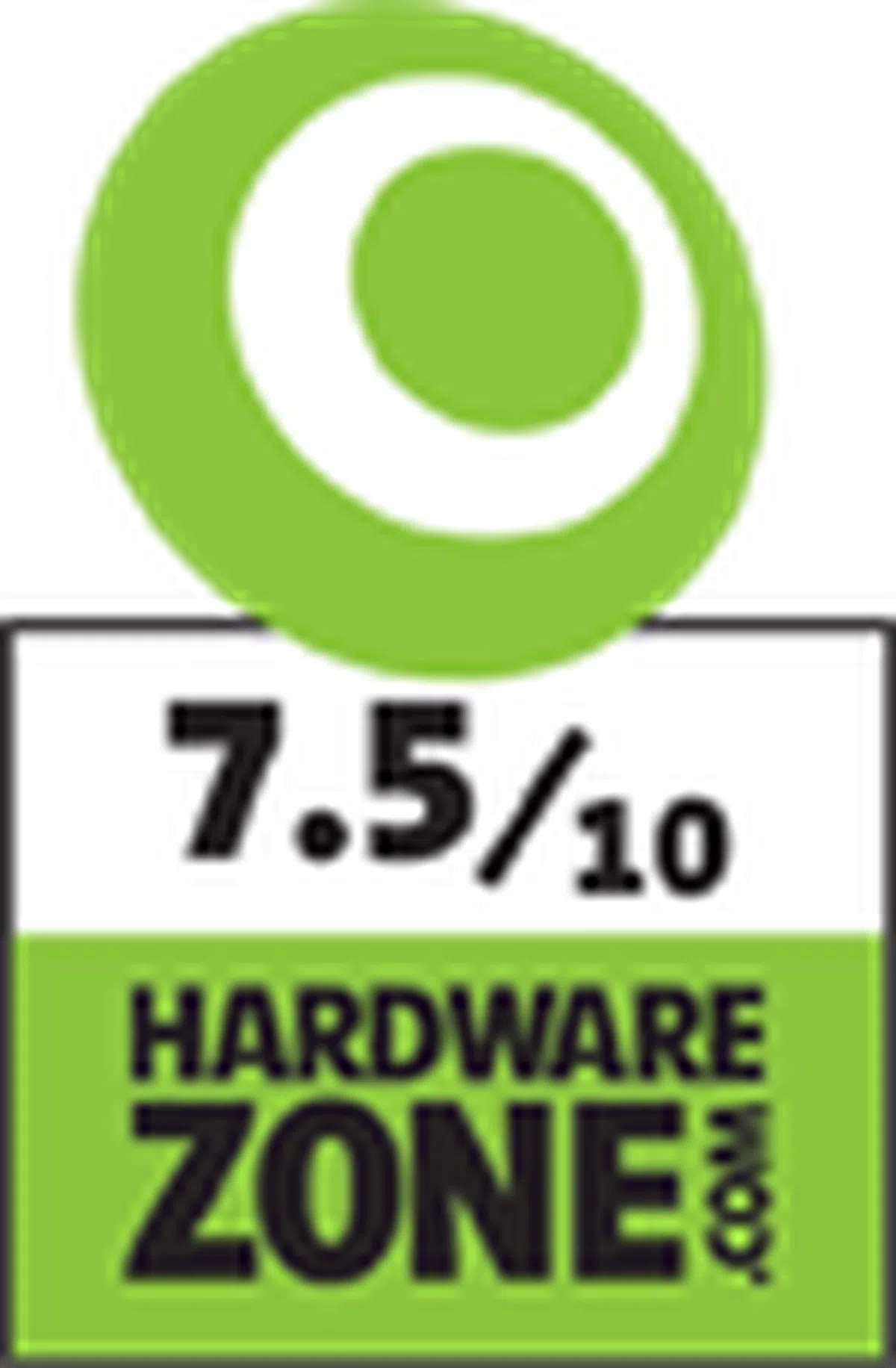 |
Our articles may contain affiliate links. If you buy through these links, we may earn a small commission.
